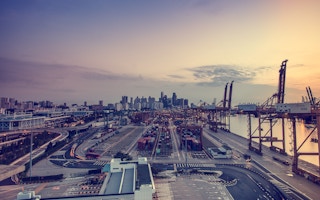Upgrading Asia-Pacific’s biggest ports to cope with the effects of climate change will cost up to $49 billion, but the bill could be even higher if no action is taken, researchers said.
Sustainability consultancy Asia Research and Engagement (ARE) analysed the risks to 53 of the region’s largest ports and estimated costs for them to adapt to rising sea levels and storm surges.
Benjamin McCarron, managing director at ARE, predicted “increasing damage to ports” from storms and related stoppages in operations if measures are not taken to prepare for global warming impacts, including more extreme weather.
“That kind of disruption would grow and continue,” he told the Thomson Reuters Foundation.
ARE’s report—commissioned by international bank HSBC—covered ports in Japan, China, Hong Kong, Taiwan, Singapore, Australia, India, South Korea and Malaysia.
It put the costs for those ports to adapt to climate change at between $31 billion and $49 billion.
Japan’s Kitakyushu port faces the highest cost at $4.9 billion, the report said, while five of the region’s 10 largest ports by capacity could see bills of more than $1 billion each.
“
This report is designed to start conversations amongst those who use and finance sea-ports in Asia by asking the multi-billion dollar question: Are you ready for climate change?
Benjamin McCarron, managing director, Asia Research and Engagement
Indonesia’s Cilacap could take steps to deal with climate change most cheaply at $65 million, the report said.
It is more expensive to fix up ports with large areas covered by warehouses than those made up mainly of yards, which can be elevated relatively easily using concrete, said McCarron.
Port owners should factor the report’s findings into their long-term plans and upgrades, while banks, insurance companies and other investors should question port operators about the resilience of their assets, he added.
Incorporating climate protection at the design stage is cheaper than doing so once a port is built, McCarron said.
The report also urged financial backers of new infrastructure, like China’s “Belt and Road” initiative, to ensure they include climate projections in construction plans to avoid higher costs in the future.
“This report is designed to start conversations amongst those who use and finance sea-ports in Asia by asking the multi-billion dollar question: Are you ready for climate change?” Wai-Shin Chan, head of climate change at HSBC, said in a statement.
This story was published with permission from Thomson Reuters Foundation, the charitable arm of Thomson Reuters, that covers humanitarian news, women’s rights, trafficking, property rights, climate change and resilience. Visit http://news.trust.org
The Thomson Reuters Foundation is reporting on resilience as part of its work on zilient.org, an online platform building a global network of people interested in resilience, in partnership with The Rockefeller Foundation.










